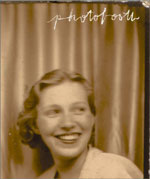Finders Keepers | |

| Okay, here's an admission: I love 'found' art. Or let me rephrase that: I love found things, full stop, and think that there's something about the nature of finding which is inherently 'artistic'. Naturally in that belief there is the no small matter of context, with intent being one of the primary contextual considerations. You see, it's not so much the finding, or the discovery itself that's inherently the artistic action (or a part of an artistic or creative process), it's more the fact that an intent of making art from found things implies that there is a willingness to look at and engage with the world. It implies seeing interest in that which most others perhaps do not and suggests an awareness of surroundings and environments. I think photography is a great 'found' medium. Photography seems to me to be all about framing the found moment, and my favourite photographs are those which frame and find interest in the everyday, or that which might at face value seem to be banal. Specifically too it's constructed sources that are of the most appeal; it seems that in the urban and suburban built environments there are so many opportunities for beautiful images to be plucked from the fabric, it's really quite dizzying. Some of my very favourite photographs of recent months have been like this; Tod Seelie's wonderful photographs of empty spaces for example leave me entranced, whilst the Greg White / Ryan Bigge / Patricio Davila Eroded Margin, which documents the desolate decay of the Knob Hill stores in North America holds many wonderful images |

| Babette Hines' Photobooth (Princeton Architectural Press) meanwhile makes a grab at the best of both worlds by collecting a whole selection of found photobooth photographs. Like Nino in Amelie, Hines has created a portfolio of questions: Who are these individuals, and what are their stories? She has made a visual vessel into which the consumer may invest a myriad of narrative answers. Thus it's up to the viewer to fill in the emptiness that surrounds the frozen moment, and of course that's the fascination. There are characters here to laugh with, to weep for, and to fall obsessively in love with, as indeed one only can with an image that passes in the blink of an eye. There are hard men and lonely looking women; exuberant teen girls with mouths filled with lollipops and dazed looking lovelorn lads. There are sailors home from the sea, in the arms of their sweethearts or shipmates (and perhaps both at once) and there are aging spinsters dreaming of brighter pasts. Photobooth is filled with the people you glimpse on buses, in parking lots, behind the counter at the convenience store in the city you passed through just the once; are the extras in the movies who catch your eye more than the stars; are the faces which creep into your dreams and which stay to haunt your waking hours. As such it's an endlessly rewarding gem. Also from Princeton Architectural Press is Cuba Style: Graphics from the Golden Age of Design. I've written in the past about contemporary fascination with Cuba and its history, and it's really that history which Vicki Gold Levi and Steven Heller's book focuses on. Whilst there is a smattering of pre-1920s material here, it's really Batista's '30s through to the pre-Castro/Che revolution '50s Cuba that is illuminated here, which means a host of imagery from a time when Cuba was a corrupt escapist paradise for American businessmen who fancied themselves a bit sharp, rough, or more frequently both. Visually rich, Cuba Style is a fascinating visit to an era of grand suits and fancy hats; of colourful scarves, drinks and language. It's a trip to a time of Art Deco hotels, when Key West and Miami were but a hop skip and a jump away; to when Edward G Robinson's Rocco might aspire to creeping over the ocean in Bacall's boat with Bogie at the helm. As both a stimulating time capsule and a designer's reference point, Cuba Style is good stuff. © 2002 Alistair Fitchett |